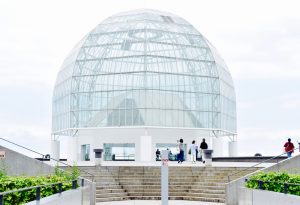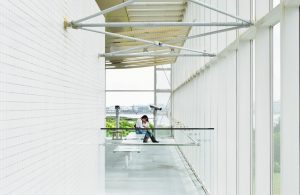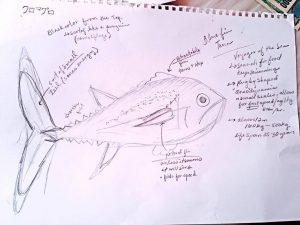Slowly working on catching up on my blogs posts… I apologize.
We just spent some time at Tokyo Sea Life Park this morning and afternoon! Again, it is not my preferred activity to look at animals in captivity, but this was not a passive experience so I enjoyed it. In the evening, we went to where Selinger 先生’s longtime friend, Emi-san, lives.
It turns out that marine life, much like the human residents of Tokyo, don’t get much living space. I was so surprised to see how small the tanks were. It wasn’t like the building itself was small though, so I’m not sure why they allotted the space they did. But I guess it’s a give-and-take because they have to display different habitats (so separate tanks), and each tank needs “breathing room” from a design perspective (can’t overwhelm the visitor too much I suppose). Meeting Tada 先生 was the highlight of today’s visit. Immediately after meeting him, he gave us all (including the senseis!) sketch books and pencils and took us to the Bluefin Tuna exhibit. His only instructions were to pay attention to the details and draw what we saw. I did not get to finish my drawing (probably for the better since it was a terrible sketch…), but it was fun! It was such a great exercise because you really appreciate and notice the fish more. We were also taken to a non-public area (I love it when we are allowed to enter restricted places) to see the top of the tuna tank. This was so we could see counter-shading in action, or how the coloring of the fish is such that it camouflages when viewed from above or below (like penguins). Afterward, to the surprise of everyone including myself, we got to touch a dead tuna! The educational context made this experience different from the the tuna I’ve touched previously (like from sushi). The cold fish died from colliding with the thick (20 cm, which is nearly 8 inches!) glass of its tank. Ever since, it has been frozen and thawed at least ten times for the purpose of having groups like us touch it.
Tada先生 was incredibly honest and sincere with us. He told us that about 30 fish die a year (which includes 25% of Bluefin Tuna). He also admitted that tanks are not very successful at recreating the appropriate ecosystems the fish need. For example, the tuna tank is about three times smaller than it should be. This was also the first time a tuna tank was made, and they thought a donut shape would be best since the fish swim in circles. However, they found out that only juveniles like to swim in circles but older tuna like to swim in straight lines. To accommodate for this, they added a wall in the middle of the tank so that some of the fish can swim in curved lines and others can swim in straight lines. In his presentation, there was also a portion about people boycotting against the zoo and the aquarium (the picture that accompanied was of people holding a sign for PetaAsiaPacific). I mentioned before that many fish die each year, which means the aquarium replaces the fish by catching more. Not too long ago, a bunch of protestors stood in front of the tank to protest against catching more tuna. What was really interesting is that Tada 先生worked at Ueno Zoo before working at the aquarium. If I remember correctly, he became an aquarist so he could focus on educating the public, which is more achievable at an aquarium than a zoo. I really appreciated how honest he was, especially coming from our experience yesterday (lots of dodging of questions and no acknowledgement of any conflict from that group of people). He talked about his struggle with the ethics of capturing animals and then keeping them in captivity. He said he justifies it by emphasizing education. While I understand this, I have a hard time thinking that this is still okay. Is education enough to say it is morally okay? It reminds me of when I took biology and we dissected around ten different animals (from sharks to frogs). There was one animal, the starfish, that my lab instructor said we might not be able to dissect because of a disease. We ended up getting them and dissecting them… I wish we had not dissected them though. Honestly, I never thought I learned more from dissecting these animals than by learning it from a book. I see the value in dissecting these animals if you’re an aspiring vet or biologist but not for someone who does not plan on studying physical bodies. I’m not saying that aquariums and zoos should not exist, but I am also not saying they are perfect.
Something cool: Later we learned that the architect of the aquarium designed the space for adults (lots of 90˚ angles and used colors like black and grey), but it turns out that most of the visitors are kids. This isn’t to say kids aren’t welcome at the aquarium; in fact, there are many displays that have varying information at different eye levels. This provokes conversation between generations, which is awesome! We were also given booklets that had an entire spread dedicated to all the programs for each age group. Lots of educational opportunities for people! He did say that it’s difficult to get high schoolers and college students involved—like Bowdoin, this place knows that the way to get us to go somewhere is by providing free food! (If they learn about a particular sea animal, they actually get to eat it haha.)
How does this compare to Ueno Zoo? Well, unfortunately, we did not get a behind-the-scenes look at the zoo, so it’s a bit hard to compare. But based on the exhibits themselves, each animal was separate from the other in a taxonomic-style of categorization. At the aquarium, the separation was based on habitat type, and it was more common that multiple species lived in one tank. For example, the tuna tank contained sardines and was supposed to mimic the deep open ocean. There was also a “coral reef of Hawaii tank” containing like ten or so species of tropical fish (haha of course I would remember this one). Sorry, I realize this is a superficial comparison, but I don’t think I can compare target audiences because I am biased by Tada 先生 (I want to say that the zoo is more recreational and the aquarium is more educational but I don’t really know what programming the zoo has to offer… perhaps I can say that though because there was more writing in the text displays at the aquarium than at the zoo?).
カラオケ is hard when you have to quickly read Japanese. However, it was fun and a much-needed break to do something light-hearted with the group. Selinger先生 and Emi-san got really into it, which was awesome! I also got to wear a yukata for the first time! The fabric was so beautiful oh my goodness (apparently the pattern I had was made through tie-dying). Luckily, we got help with putting it on, as there was no way I could tie a bow that nice. For dinner, we ate a Japanese vegetarian meal prepared by Emi-san. I wish we got to see pictures of younger Selinger 先生! Oh well. Regardless, it was great to experience a Japanese home and home-cooked meal. I’m curious as to why the toilet is separate from where you wash your hands and shower/bathe. That’s how it is in our AirBnB, too, and I don’t really see the purpose? And why does the toilet run water (like a mini-sink with no soap) above it?




